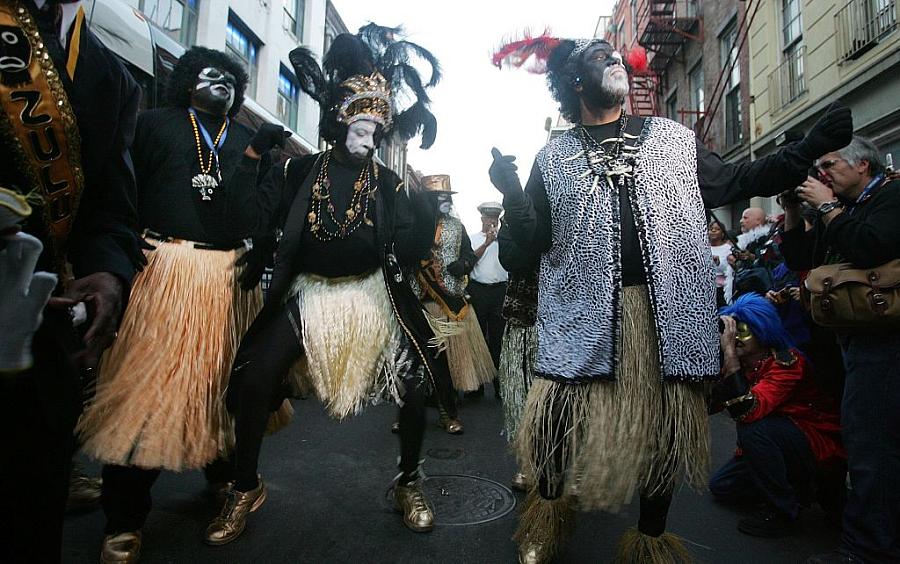For NYT writer Linda Villarosa, intimate narratives tell the story of race and health in America

Members of the Zulu Social Aid and Pleasure Club dance in the French Quarter during Mardi Gras festivities in New Orleans (Photo by Mario Tama/Getty Images)
For New York Times Magazine contributing writer Linda Villarosa, a good story starts with a statistic. “I get started with a number that doesn’t make sense, so it makes me mad or there’s just something weird about it, such as how the U.S. is the only country where the number of women who died or almost died in childbirth related to pregnancy is rising when we have such expensive health care.”
From there, Villarosa creates a structured outline that she’ll eventually translate into the sweeping accounts of personal turmoil, powerful narratives, and overarching revelations about systems of power and their impacts on our lives and well-being.
Villarosa recently shared her storytelling process with the Center for Health Journalism’s 2021 California Fellows via Zoom, where she shared tips on finding stories, structuring your reporting, and picking the right sources for strong narratives.
Villarosa walked Fellows through one of her most memorable stories for The New York Times Magazine, where she chronicled the pandemic’s heavy toll on the Zulu Social Aid and Pleasure Club in New Orleans. Several members of the Mardi Gras organization fell ill with COVID-19 and many died from complications of the disease early in the pandemic, after city officials failed to cancel the annual celebrations as cases of the virus cropped up in other cities around the country.
Although racial health disparities in COVID-19 deaths were already becoming apparent, mainstream media hadn’t caught up to the story and national data hadn’t emerged yet. Villarosa got in touch with Jay H. Banks, chairman of the Zulu Club’s board, after she noticed multiple posts about members dying of the virus on the club’s Facebook page. Her interview with Banks provided crucial context for Villarosa’s heart-wrenching piece:
“Zulu is 800 men, predominantly Black,” Banks told her. “Like all Black communities, we have a large contingent of people who have pre-existing conditions. Our members come from all walks of life, and many of them don't have jobs with sick days and don't have the luxury of working at home. When you add these factors to a disease that capitalizes on these kinds of circumstances, you get a perfect storm.”
The story did what several of Villarosa’s pieces so often do: offer a big sweep of history to establish the context in which the country’s systemic health disparities are rooted, while using detailed personal narratives to drive the theme home.
As for many journalists, reporting has looked quite different for Villarosa since the pandemic began. She described how she interviewed Mrs. Charles, one of the widows of a deceased Zulu club member, over Zoom because of COVID restrictions. Remote reporting forced Villarosa to rely on the woman’s descriptions of scenes in her husband’s life down to minute details, such as what he liked to serve at his Sunday barbecues, and the music that played during her time in the hospital with him.
When a fellow journalist asked Villarosa how to know when you’re pushing too far as a reporter during an interview, Villarosa shared how she first built trust with Mrs. Charles before trying to access the intimate details of her husband’s life. She told the widow, “I’m not writing a story about a bunch of dead Black men, I’m writing a love story about you and your husband and how you care for him, and how it’s a tragedy that such a nice man died because of this weird scary disease. I’m writing about a bunch of men who were doing something good for the community and providing fun and joy, then this happened.”
Villarosa also recounted her experience reporting on Black maternal health disparities. For one story, she had to ask a grieving mother to describe what her deceased baby looked like, down to the color of her hair. “It was hard and I was trying to make sure not to retraumatize her, but I felt like those details mattered,” Villarosa said.
She made the decision to share with the mother her own experience with childbirth complications in her reporting on the topic, saying: “This isn’t just a problem of women with no means or who have had really rough lives. It’s also Black women whose lived experience just being Black is harmful, even if we manage to get educated and manage to overcome our circumstances.”
Another journalist asked for advice on how to approach reporting that hits close to home, especially for journalists of color whose objectivity may be questioned when reporting on their communities.
Villarosa advised reporters to stick to the numbers, and let data do the talking when dealing with editors unfamiliar or uninterested in the topics you bring to them. She also pushed back against the notion that any reporting can be truly objective, especially in a media structure largely upheld by older white men less knowledgeable about communities outside their spheres of personal experience.
Said Villarosa, “What I have found is that if we’re not telling the stories, no one is telling the story.”

